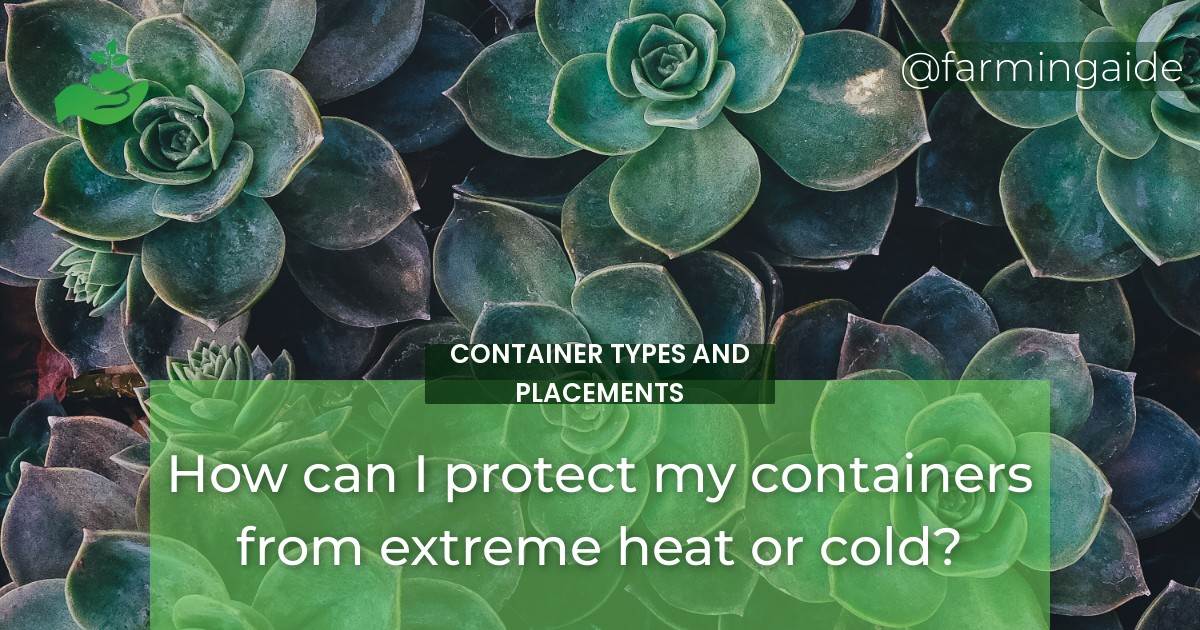Container gardening is a great way to grow plants, especially when you have limited space. However, the plants and containers are prone to damage from extreme temperatures. So, how can you protect your containers from extreme heat or cold?
Techniques to safeguard containers and plants from extreme temperatures
Protecting containers from extreme heat
During the hot summer months, containers can get too hot, which can damage or kill the plants inside. Here are some tips to protect your containers from extreme heat:
Choose the right container
- Use light-colored containers that reflect sunlight instead of darker containers that absorb heat
- Choose containers made of porous materials, such as terra cotta or clay, that allow water and air to circulate to the roots
- Avoid black plastic containers that can heat up and damage the roots of the plants
Use appropriate soil and mulch
- Use a high-quality potting mix that retains moisture and allows for proper drainage
- Add mulch around the plants to help retain moisture and keep the soil cool
Provide shade and ventilation
- Place the containers in a shaded area, such as under a tree or awning
- Use shade cloth or a trellis to provide shade for the plants
- Use a fan or other device to provide ventilation to the plants
Water frequently and deeply
- Water the plants frequently, especially during the hot summer months
- Water deeply to ensure that the roots get enough water
- Water early in the morning or late in the evening to avoid evaporation
Add insulation to the container
- Use insulating materials, such as foam board or bubble wrap, to line the container
- Place the container on a foam pad to insulate it from the hot ground
Protecting containers from extreme cold
During the winter months, containers can get too cold, which can damage or kill the plants inside. Here are some tips to protect your containers from extreme cold:
Choose the right container
- Use containers made of thick materials, such as ceramic or concrete, that hold heat
- Choose containers that are smaller in size so that they can be moved indoors during extreme cold weather
Use appropriate soil and mulch
- Use a high-quality potting mix that drains well and does not become waterlogged
- Add mulch around the plants to protect the roots from freezing
Provide insulation to the container
- Wrap the container in an insulating material, such as burlap, to help keep the roots warm
- Place the container on a wooden pallet to provide additional insulation from the cold ground
Cover the container
- Use a frost blanket or tarp to cover the container at night
- Remove the cover during the day to allow the plants to get sunlight and air
Group containers together
- Grouping containers together helps to trap heat and protect the plants from the cold
- Place the containers close together, but not touching, to allow for air circulation
Water the plants appropriately
- Water the plants when the soil is dry, but do not overwater
- Water early in the day so that the water has time to soak into the soil before it freezes at night
Use anti-transpirants
- Anti-transpirants, such as Wilt-Pruf, can be sprayed on the leaves of the plants to help reduce moisture loss
- This can help the plants survive during extreme cold weather
Placing containers in the right location
In addition to protecting the containers from extreme temperatures, it is important to place them in the right location. Here are some tips:
Consider the microclimate
- Take into account the temperature, humidity, and wind patterns of the area where the containers will be placed
- Choose plants that are appropriate for the microclimate
Choose the right exposure
- Place the containers in an area that gets the right amount of sunlight for the plants
- Some plants need full sun, while others need partial or full shade
Use windbreaks and barriers
- Wind can dry out the soil and damage the plants
- Use barriers, such as a fence or hedge, to protect the containers from the wind
Conclusion
Protecting containers from extreme temperatures requires some planning and preparation, but it can be done. By choosing the right containers, soil, and location, and by providing insulation, shade, and ventilation, you can help your plants survive even during the hottest or coldest months of the year. Use these techniques to safeguard your containers and plants from extreme temperatures:
Recap of techniques to safeguard containers and plants from extreme temperatures:
- Choose the right container
- Use appropriate soil and mulch
- Provide shade and ventilation
- Water frequently and deeply
- Add insulation to the container
- Wrap the container in an insulating material
- Cover the container
- Group containers together
- Water the plants appropriately
- Use anti-transpirants
- Consider the microclimate
- Choose the right exposure
- Use windbreaks and barriers
RELATED ARTICLES:


